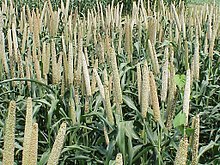Our website is made possible by displaying online advertisements to our visitors.
Please consider supporting us by disabling your ad blocker.
Millet

Millets (/ˈmɪlɪts/)[1] are a highly varied group of small-seeded grasses, widely grown around the world as cereal crops or grains for fodder and human food. Most millets belong to the tribe Paniceae.
Millets are important crops in the semiarid tropics of Asia and Africa, especially in India, Mali, Nigeria, and Niger, with 97% of production in developing countries.[2] The crop is favoured for its productivity and short growing season under hot dry conditions. The millets are sometimes understood to include the widely cultivated sorghum; apart from that, pearl millet is the most commonly cultivated of the millets.[3] Finger millet, proso millet, and foxtail millet are other important crop species. Millets may have been consumed by humans for about 7,000 years and potentially had "a pivotal role in the rise of multi-crop agriculture and settled farming societies".[4]
- ^ "Definition of millet". Oxford Dictionaries. Oxford University. Retrieved 21 July 2017.
- ^ McDonough, Cassandrea M.; Rooney, Lloyd W.; Serna-Saldivar, Sergio O. (2000). "The Millets". Food Science and Technology: Handbook of Cereal Science and Technology. 99 (2nd ed.). CRC Press: 177–210.
- ^ "Annex II: Relative importance of millet species, 1992–94". The World Sorghum and Millet Economies: Facts, Trends and Outlook. Food and Agriculture Organization of the United Nations. 1996. ISBN 978-92-5-103861-1.
- ^ Cherfas, Jeremy (23 December 2015). "Millet: How A Trendy Ancient Grain Turned Nomads Into Farmers". National Public Radio. The Salt. Retrieved 4 May 2018.
Previous Page Next Page


